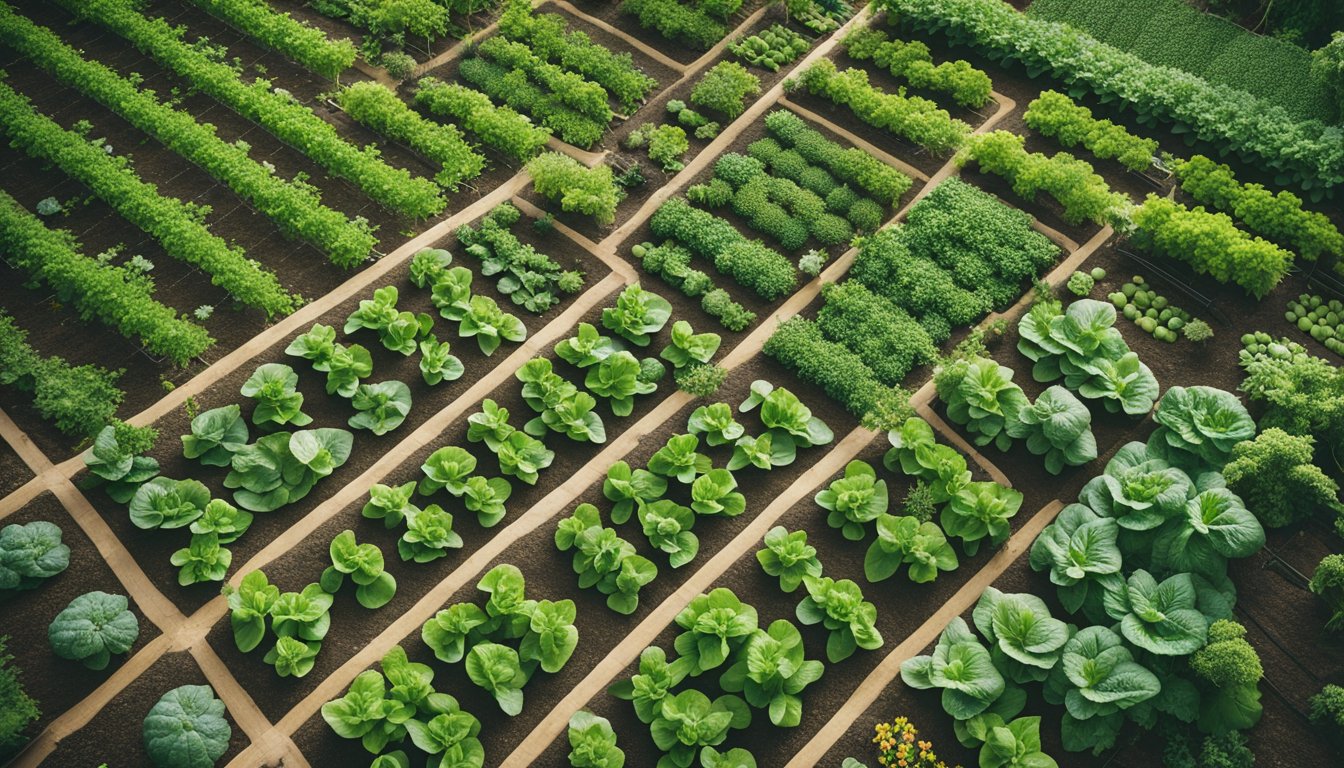If you’re looking to maximize your gardening space while enjoying a bountiful harvest, an intensive cropping vegetable garden might be just what you need. This innovative approach allows you to grow more vegetables in less space, making it perfect for urban gardeners or anyone with limited room. Imagine stepping into your backyard and being greeted by a vibrant array of fresh produce, all thriving in harmony.
By embracing techniques like companion planting and vertical gardening, I’ve transformed my small plot into a lush oasis of flavors and colors. Not only does this method boost your yield, but it also promotes healthier plants and reduces the need for harmful pesticides. Dive into the world of intensive cropping, and discover how you can cultivate a thriving vegetable garden that’s both sustainable and rewarding.
Overview Of Intensive Cropping Vegetable Gardens
Intensive cropping vegetable gardens make the most of limited space. This method allows me to grow various vegetables in a small area. By using techniques like companion planting, I boost plant health and improve yields.
I often use vertical gardening to save ground space. With climbing vegetables, my garden looks more lively and productive. It’s amazing how a simple trellis can change the game!
To optimize my garden further, I carefully plan the layout. I group plants with similar needs together, reducing competition for nutrients, light, and water. This strategic arrangement keeps my garden flourishing.
In addition, I focus on crop rotation. This method prevents pests and diseases from establishing a stronghold. It also helps maintain soil fertility.
I find that intensive cropping encourages more frequent harvesting. Regular picking promotes new growth, leading to even larger harvests. Who doesn’t love a bountiful vegetable basket?
Finally, by minimizing space between plants, I create a more vibrant ecosystem. Beneficial insects find a home among the dense foliage. This diversity plays a vital role in my garden’s health.
Benefits Of Intensive Cropping

Intensive cropping offers significant advantages for vegetable gardeners. Maximizing output while utilizing limited space makes this gardening method appealing.
Increased Yield
Intensive cropping boosts yield per square foot. I can plant more varieties closely together. Companion planting works wonders. For example, placing tomatoes near basil enhances both plants’ growth. Frequent harvesting leads to bigger crops. I notice that a diverse garden encourages faster growth and healthier plants. Plants share resources and space effectively. Plus, the added variety attracts beneficial insects, which aid pollination.
Efficient Use Of Space – Intensive Cropping Vegetable Garden
Efficiency plays a crucial role in intensive cropping. Using vertical gardening techniques allows me to utilize every inch efficiently. I can grow cucumbers and beans on trellises. Square-foot gardening gives me the freedom to plant several crops in the same area. Mixing root vegetables with leafy greens takes advantage of different growth patterns. A well-planned layout makes a small garden feel expansive. I often find that creative spacing enhances sunlight and airflow, improving plant health. This method transforms even the tiniest balcony into a vibrant garden oasis.
Techniques For Successful Intensive Cropping
Intensive cropping offers various methods to boost harvests. These techniques maximize space and enhance growth. Here are some key strategies.
Raised Beds
Raised beds improve drainage and soil quality. I often see gardeners using them for better access and organization. They warm up quicker in spring, allowing earlier planting. I like to fill mine with rich, organic soil to support healthy plant growth. This method also makes it easier to control weeds and pests, leading to happier plants and bigger yields. It’s like giving my veggies a luxury hotel to thrive in!
Companion Planting – Intensive Cropping Vegetable Garden
Companion planting pairs helpful plants together for mutual benefit. I’ve enjoyed growing tomatoes with basil for a delicious combo that helps promote growth. Some plants repel pests, while others attract beneficial insects. Mixing crops like this boosts productivity and can minimize chemical use. I’ve noticed that my garden buzzes with life when I include flowering plants alongside my vegetables. Plus, it’s a great way to add variety to my plates, making meals even tastier!
Embracing these techniques makes intensive cropping a rewarding venture. I find joy in watching my garden flourish with these simple, effective practices.
Common Challenges And Solutions

Gardening can be a tough gig, but understanding the challenges of an intensive cropping vegetable garden can make things easier. Here’s a look at two common hurdles and their solutions.
Pest Management
Pests love a good vegetable garden. They can munch through your hard work in no time. To combat pests, I rely on proactive measures. I plant flowers like marigolds to attract beneficial insects that feast on those pesky critters. Additionally, I use row covers to protect seedlings from being snacked on. Regular inspections help me catch any infestation early. If I spot trouble, I opt for organic remedies like neem oil or insecticidal soap. It’s always best to tackle pest problems before they turn into a feast.
Soil Fertility – Intensive Cropping Vegetable Garden
Poor soil can hold back even the best plants. It’s essential to keep soil fertile to maximize a garden’s potential. I start with a soil test to understand nutrient needs. Amendments like compost or aged manure provide a nutrient boost. Rotating crops each season keeps nutrients balanced. I also consider planting cover crops during the off-season. These crops prevent erosion and improve soil health, adding organic matter. Maintaining healthy soil means my vegetables start strong and continue to thrive. Plus, who doesn’t love a garden that gives back?
Before You Go – Intensive Cropping Vegetable Garden
Embracing an intensive cropping vegetable garden has truly transformed my gardening experience. I’ve seen firsthand how maximizing space can lead to bountiful harvests even in limited areas. By using techniques like companion planting and vertical gardening, I’ve not only enhanced my yields but also created a thriving ecosystem.
The joy of frequent harvesting and nurturing diverse plants is incredibly rewarding. I’ve learned that careful planning and creativity can turn any small space into a vibrant garden. As I continue to experiment with these methods, I’m excited to see how my garden evolves, proving that even the smallest plots can yield impressive results. Don’t forget to add The Herb Prof to your favorites so you don’t miss out on future articles.
References – Intensive Cropping Vegetable Garden
Little Herb Encyclopedia, by Jack Ritchason; N.D., Woodland Publishing Incorporated, 1995
The Ultimate Healing System, Course Manual, Copyright 1985, Don Lepore
Planetary Herbology, Michael Tierra, C.A., N.D., Lotus Press, 1988
Handbook of Medicinal Herbs, by James A. Duke, Pub. CRP Second Edition 2007
The Complete Medicinal Herbal, by Penelope Ody, Published by Dorling Kindersley
Check the Following Articles
Managing Oxalis Weeds in Lawn: Effective Tips
Choosing the Best Plastic for Polytunnel
Aloe Vera For Skin Blemishes: Top Benefits
Do Liver Support Supplements Work? Herbs for Liver Health
Frequently Asked Questions – Intensive Cropping Vegetable Garden
What is intensive cropping in a vegetable garden?
Intensive cropping involves maximizing the yield of a vegetable garden by planting crops closer together. This technique boosts production per square foot and is particularly beneficial in urban or small spaces.
How can companion planting enhance my garden?
Companion planting pairs compatible plants, like tomatoes and basil, to enhance growth, attract beneficial insects, and minimize pests. This method can lead to healthier plants and increased yields.
What is vertical gardening and why is it useful?
Vertical gardening utilizes vertical space to grow plants, making it ideal for limited areas. It enhances air circulation, sunlight exposure, and allows for more diverse crop planting in small spaces.
How do I plan my garden layout for intensive cropping?
Focus on grouping plants with similar needs (water, light). Plan vertical structures and raised beds for better drainage and soil quality, ensuring efficient use of space for maximum yield.
What techniques can help manage pests naturally?
Consider planting marigolds to attract beneficial insects, using row covers for protection, and applying organic remedies like neem oil to keep pests at bay without chemicals.
Why is crop rotation important in intensive cropping?
Crop rotation prevents soil depletion and reduces pest build-up. By alternating crops each season, you enhance soil fertility and manage diseases, promoting a healthier garden.
How can I improve soil fertility in my garden?
Improve soil fertility with compost or aged manure, conduct soil tests to assess nutrient needs, and plant cover crops during the off-season to enrich the soil naturally.
What are the benefits of having a diverse vegetable garden?
A diverse garden encourages faster growth, healthier plants, and helps attract beneficial insects for pollination. It creates a balanced ecosystem that supports overall garden health.

